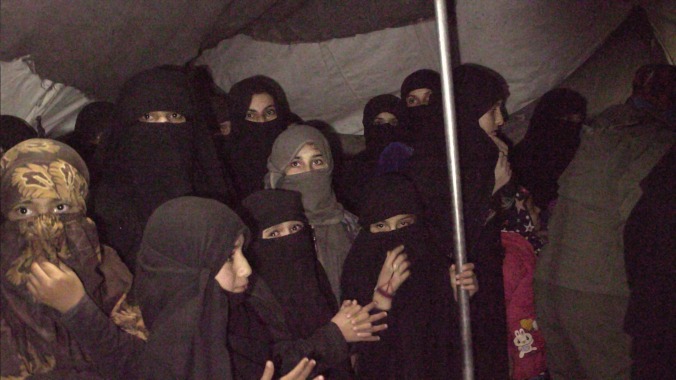Sabaya offers a firsthand account of a dangerous search and rescue operation
It's an intense but incomplete documentary about efforts to save the girls kidnapped by The Islamic State
Film Reviews Sabaya

An arid road leads a van in and out of danger in director Hogir Hirori’s firsthand documentary Sabaya. At the risk of being ambushed, the vehicle transports precious cargo between the Al-Hol Camp housing captured supporters of The Islamic State near the Syria-Iraq border and the Yazidi Home Center, where girls rescued from the terrorists’ grasp are provided shelter. Though the area is more or less under Kurdish control, there’s a latent threat of attack. Positioning his camera in the front seat, Hirori reveals a small operation to save girls turned into sabayas, a term The Islamic State uses to refer to Yazidi women they’ve taken as sex slaves. Girls as young as 7 years old are kidnapped and forced into despicable acts; the age of the victims often doesn’t exceed 13. Since the Yazidis, a Kurdish ethnic group with their own language and culture, are not Muslim, they are brutally targeted.
The filmmaker, himself a native of Iraqi Kurdistan who escaped to Sweden, conducts virtually no interviews with any of the subjects, instead building a narrative from a series of missions and their outcomes. Perpetually on the phone, planning their next move or connecting with informants, Mahmud is our inexpressive protagonist. Nothing is revealed about when or how he and his partner, Ziyad, started conducting this selfless endeavor or if there are personal stakes tied to their commitment. Snippets of an overheard marital dispute communicate the frustration Mahmud’s wife feels due to his long absences and absentminded state, but that’s as intimate as it gets. Such professional pragmatism, the way the film resists disclosing the men’s history or motives, might very well be a matter of security. But it raises lots of questions about who they are and how they pull it all off on limited resources.
Mahmud’s nearly unbreakable concentration is repeatedly soundtracked by news broadcasts that cover the larger geopolitical implications of what’s happening on the ground. From that semi-inconspicuous device and some onscreen text, we are meant to infer greater themes. Otherwise, the film offers intense images of peril. Fruitful searches for the girls’ identities (their names and birthdates are changed, making it more difficult to locate them) give way to hazardous nocturnal rescue missions. A nail-biting sequence sees Ziyad, a driver with nerves of titanium, trying to lose an enemy pursuing them through the darkness. Hirori’s willingness to keep filming during unpredictable situations is audacious and commendable. For contrast, he also offers moments of calm domesticity within the Yazidi Home Center, finding the normalcy of meal preparation or a child playing within a chaotic environment.
Engrossing though these glimpses of pedal-to-the-metal heroism are, the doc falters in failing to spotlight the role women play in these liberation operations. Mahmud relies on infiltrators, women that pretend to be Islamic State sympathizers inside the Al-Hol community to mine details about the teens’ whereabouts before they are sold or killed. Some of them are former sabayas, and though they risk their own lives for others, they don’t get much screen time here. Even if their faces were blurred and their voices distorted to protect their identities, it would have enriched the film to get their perspective—to hear them speak of their unbelievable bravery. Footage recorded inside the camp with a camera under the women’s veil, the fabric partially covering the lens, bookends the story. For a few moments, we are allowed a glimpse behind the curtain of their world. Strangely, it’s a very fleeting one.
Hirori more intentionally engages with the harsh reality facing the women brought to safety. The disheartening aftermath is often a whole new ordeal: returning to families that reject their children born out of rape in captivity, or discovering that they no longer have any living family to return to. In a rare moment of someone directly addressing the camera, a girl enslaved for years ponders what’s left to live for now that her entire family has been murdered. “Soon you will learn I committed suicide,” she declares with unnerving certainty. Her blunt statement confirms that the road to recovery doesn’t end once Mahmud and Ziyad’s car stops at their organization’s doors.
On that topic, the 2018 documentary On Her Shoulders, chronicling the efforts of Yazidi survivor and speaker Nadia Murad to enact justice, offers a more considered portrait. As a journalistic depiction of the rescue operations as they happen, Sabaya brims with heart-pounding tension and immediacy. But given the access obtained and Hirori’s connection to the people and the land where this grim chapter in modern history is unfolding, the superficial handling of pivotal aspects of the story is disappointing.
4 Comments
If it weren’t for the Kurds, ISIL would be at the gates of Beirut right now. Then you’d have Syrian, Palestinian, Jordanian, and Lebanese men/women/children drowning in jury-rigged rafts off the coast of Greece and Spain and Italy. And Trump threw them to the Turks.
The Kurds have been getting dumped on for centuries, unfortunately 🙁
We screwed them over 3 times in the last 30 years.
“Availability: In Select Theaters”Oh, so not available because we are still IN A PANDEMIC.